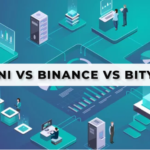Padre.gg bundles multi-chain trading, advanced order types, discovery, analytics, mobile access, and fee incentives into a single self-custodial terminal—aimed at making on-chain trading simpler and safer for beginners and power users alike. In this article, we will deep dive into what Padre.gg platform offers to its users.
Table of Contents
What is Padre.gg?
Padre is a web trading terminal for on-chain tokens—especially fast-moving meme coins and early launches. It aims to feel like a centralised exchange (clean charts, clear order panel, portfolio view) while staying self-custodial: you hold the keys; trades settle directly on the blockchain.
Supported chains: Solana (SOL), Ethereum (ETH), Base (ETH L2), and BNB Chain (BSC). You can switch chains inside the app without changing websites, and manage multiple wallets in one place.

How does Padre.gg work?
- You connect or import a wallet. Your private key is encrypted locally with a password you set.
- When you place a trade, Padre builds and sends the transaction to the chain (via smart routing), then shows confirmations and fills in the terminal.
- Because it’s on-chain, you still pay network gas and you’re subject to on-chain realities like slippage and liquidity—Padre’s job is to make that smoother and faster.
Why this matters: Memecoin markets move in seconds. A terminal that reduces failed transactions, lets you pre-plan exits, and consolidates wallets/chains in one screen gives you a real operational edge—especially if you’re new.
Who is it for?
- Beginners who want a simple dashboard to try on-chain tokens without learning bots. You’ll appreciate the CEX-like order panel, tooltips, and the portfolio view.
- Intermediate traders who want speed and control: limit/market orders, slippage presets, MEV protection (where supported), and multiple exit rules to automate risk.
- Advanced users who hunt early launches, track “smart money,” or manage several wallets across chains, and need copy trading, wallet analytics, and discovery tools in one place.
- Not ideal for: people who want hand-holding or zero risk. Memecoins are volatile; you should be comfortable with on-chain fees, wallet security, and self-custody basics.
Features and Products
1) Multi-chain terminal
Trade Solana, Ethereum, Base, BNB from one interface. Switch chains via a top bar or menu; the token list, charts, and order panel update for that network.
Why it helps: No more juggling different DEX UIs or wallets. You can chase opportunities where they appear and still see your combined portfolio.
Tips: Keep a small amount of each chain’s native gas token (SOL/ETH/BNB) in your trading wallet so you’re never stuck.

2) Advanced orders (CEX-style on DEX rails)
Available types:
- Market (buy/sell now at best available price)
- Limit (execute only at your chosen price or better)
- Stop-Loss & Take-Profit (attach exits to your entry so you don’t babysit the chart)
- Multi-exit plan (e.g., sell 25% at +30%, another 25% at +60%, keep a runner)
Why it helps: You can pre-plan both entries and exits, which is vital in memecoin trading.
How it works: You set parameters in the order panel (size, price, slippage, TP/SL levels). Padre places and tracks those conditions on-chain or via the app’s order logic, and updates your Portfolio when fills happen.
Warning : On thin liquidity pairs, use conservative size and a limit order to reduce slippage.

3) Trenches (early-launch radar)
Trenches help surface very new tokens (e.g., bonding-curve launches) with quick-scan metadata: liquidity, recent trades, holder distribution, dev/wallet signals, etc.
Why it helps: Early entries are where big moves can happen—but also where rugs occur. Trenches give you signals to avoid obvious traps.
Tip: Sort by chain, skim liquidity and holders, look for excessive concentration (one or two wallets owning most of the supply = risk), then size small.

4) Copy trading & wallet tracking
Copy trading allows you to follow wallets you consider “smart,” see their trades and historical PnL, and optionally mirror their buys/sells with your own limits.
Why it helps: Great for learning and idea discovery; can be semi-hands-off if you trust a wallet’s behavior.
Controls: Set your max position size, whitelists/blacklists, and slippage rules so you don’t over-allocate or chase bad fills.
Warning: Past performance ≠ future results; wallets can change behavior or shill illiquid tokens.

5) Smart routing & transaction reliability
Padre tries to route your swap through the best path (AMMs/aggregators) to improve price and reduce failed transactions.
Why it helps: Every second and every basis point matters in memecoin markets.
Reality check: No router is perfect—expect occasional failed or partially filled trades, especially during chain congestion.

6) Portfolio analytics
Portfolio analytics helps you analyse balances, open positions, PnL, trade history across your connected wallets and chains.
Why it helps: You see the whole picture—which tokens drive gains/losses, which wallets perform, and where you’re overexposed.
Tip: Review PnL per wallet weekly; cut losers early and free up gas for better setups.

7) Presets for speed
The trader can save their transaction settings (slippage, priority/fees, MEV toggle where supported) as named presets.
Why it helps: In a fast market, you don’t want to reconfigure slippage or gas every trade.
Tip: Create a conservative preset (tight slippage) and an aggressive preset (for hype launches). Use the conservative one by default.

Security
- Self-custody: You hold the keys. When importing, the private key is encrypted with your password. Padre says it can’t access your key and doesn’t store your password.
- Turnkey infrastructure: Key operations are mediated by a professional key-management stack.
- 2FA + password-based decryption: Even with your app session, an attacker still needs your password to decrypt the key.
- MEV protection & settings: Where supported, toggle MEV protection; always set slippage thoughtfully.
- Rug-Pull Alerts: This platform allows you to track developer wallets, contract deployments, and questionable activities using Rug-Pull Alerts & Dev Signals.
- Transaction safety checks: Checks for transaction safety can identify possible issues before they cost you gas.
- Your job: Back up seed + password offline, use official links, keep your device clean. If you lose the password/seed, there’s no reset.
Pricing & Fees
Padre’s business model is straightforward: it takes a small in-app trading fee when you place a trade through the terminal. A chunk of this revenue is then used for cashback, referral rewards, and revenue sharing for $PADRE token holders.
What you pay on each trade
When you trade, your total cost has a few parts:
- Padre app fee — the platform’s own fee for using the terminal.
- Blockchain gas — paid to the network (SOL/ETH/BNB/Base), not to Padre.
- Slippage/price impact — market movement during execution (not a fee to Padre).
- Failed transaction gas (if it happens) — gas spent if a transaction fails.
Tip: Exact app fees can vary by chain/feature. Do a tiny test trade to see the real, all-in cost on your setup.
Ways to lower your net cost
- Cashback: Everyone gets cashback; it’s higher if you signed up with a referral.
- Referrals: Invite friends — you earn a share of their fees, they keep boosted cashback.
- $PADRE token perks: Holding $PADRE can reduce in-app fees and may qualify you for revenue sharing.
Quick example (illustrative)
If the app fee were 1.0% and your referral cashback is 35%, plus a 10% fee reduction from holding $PADRE, your effective app fee would be roughly:
1.0% × (1 − 0.35) × (1 − 0.10) ≈ 0.585% (you still add gas and any slippage).
Padre earns from the platform fee, while gas and slippage are outside its control. Your net cost can drop a lot if you use a referral, collect cashback, and hold $PADRE. Always test with a small amount first to see the actual cost on your chain.
Best practice: do a tiny test trade on each chain you use to learn the real cost (gas + platform fee + slippage) before scaling.

User Interface & Experience (UI/UX)
- CEX-style, readable design: Polished layout, clean charts, responsive behavior, and high-contrast typography for fast decision-making.
- Discovery with safety cues: Search by name/address, Trending/New Pairs, and Trenches for early launches—enhanced by freeze-authority/contract-risk flags and one-tap block-explorer links.
- Streamlined trading panel: One-tap sizing (25/50/100%), real-time slippage/gas/fee preview, built-in Stop-Loss/Take-Profit, plus clear order status (submitted → pending → confirmed/failed) with helpful error tips
- Portfolio + position awareness: Unified balances, positions, PnL, and history across wallets/chains—on each token page see holdings, average entry, break-even, and quick watchlist/favorites.
- Transaction presets & gas nudges: Save Conservative/Standard/Aggressive presets for slippage/priority/MEV; get reminders when native gas is low so exits don’t fail.

Mobile App (PWA)
- Install Padre as a Progressive Web App from your mobile browser or share and add it to your home screen of your mobile.
- You get near-native performance: discovery (Trending/Trenches), orders (Market/Limit/TP/SL), presets, and Portfolio on the go.
- Hence, this makes it accessible through any mobile device: iOS or Android.

Referral Program & Rewards
- Whenever you make a trade on this platform you get paid a cashback in SOL. By default all users are offered a 10% cashback on their trading fees.
- Referrals: Your invitees usually get higher cashback of up to 35%, and you earn a share of their activity.
- Rewards / revenue sharing: Holding $PADRE can qualify you for a share of platform revenues and additional perks.
- For the $PADRE token in particular, the project has reduced token trading taxes from 2% to 0%. Standard platform fees and blockchain gas costs are unaffected, but this modification guarantees that traders retain a larger portion of their wealth while utilising the token.
- The more $PADRE you own, the more benefits you can get. Deeper fee reductions, entry to the revenue-sharing pool, and the possibility for premium features only available to bigger holders are a few of these. A user can get more value out of the platform if they have more tokens.
- Tip: Even if you don’t buy PADRE yet, start with a referral link for better cashback while you learn.

How to Get Started with Padre.gg?
- Open from official links and create an account.
- Create/import a wallet → set a strong password → back up your seed offline.
- Pick a chain (SOL/ETH/Base/BNB) and fund gas in your active wallet.
- Set presets (slippage/priority/MEV). Keep one conservative, one aggressive.
- Discover a token (Trending/Trenches/search). Check liquidity and holders on the token page.
- Place an order (Market for speed, Limit for control). Attach TP/SL at entry.
- Monitor and scale out via your exit rules. Track PnL in Portfolio.
- Turn on cashback/referral and consider $PADRE perks if you plan to trade frequently.

Customer support
Here are the main support options you can use with Padre.gg:
- Discord community & support (current home): Padre says it has moved support and community activity to Discord; join their server for help channels, announcements, and discussion.
- Telegram support (legacy / direct app help): The docs list a Telegram support handle for app issues. Note that public chat has been set to read-only as they shift to Discord.
- Official Docs (Help Center): A structured GitBook with app guides, FAQs, tips & tricks, and feature walk-throughs (Trading, Transaction Settings, Automations, New Pairs, Portfolio, etc.). Great for self-serve answers.
- Official Links hub: A page consolidating trusted entry points (site, app, socials). Use this to avoid phishing and find the right support channel quickly.
- Announcements / updates on X (Twitter): Platform news, updates, and policy changes (like the Discord move) are posted on the @PadreApp account.
Conclusion
For beginners who want a clear, CEX-like interface but still trade on-chain, Padre.gg offers a strong mix of speed, control, and discovery tools. Start with tiny sizes, set TP/SL from trade one, use presets, and enable cashback/referral. As you gain confidence, layer in multi-exit plans, copy trading, and (if it fits your plan) $PADRE perks. If you prefer low-volatility coins or don’t want to manage wallet security, a simpler DEX or a big centralized exchange may suit you better.
How do I start memecoin trading?
- Set up a self-custody wallet (e.g., Phantom, MetaMask). Write down your seed phrase offline.
- Choose a chain (Solana/Ethereum/Base/BNB) and fund gas (SOL/ETH/BNB) plus a small trading amount.
- Use a trusted terminal (e.g., Padre.gg). Start on one chain to keep it simple.
- Research the token: check liquidity, holders, contract flags (e.g., freeze authority), and recent trades.
- Start tiny and prefer Limit orders; set Stop-Loss/Take-Profit so exits are automatic.
- Tune settings: conservative slippage, MEV protection where available, save a preset.
- Track your PnL and fees; scale only after consistent results.
- Stay safe: never share your seed/password; use official links; beware hype and illiquidity.
How can I claim the rewards on Padre?
This platform offers a panel with which the trader can autoclaim their rewards
How to maximise the revenue sharing rewards?
Step 1: Hold $PADRE tokens.
Step 2: Link and designate your wallet in Padre.
Step 3: Trade consistently to multiply rewards (up to 4x).
Step 4: Stay engaged and invite more traders to join.










